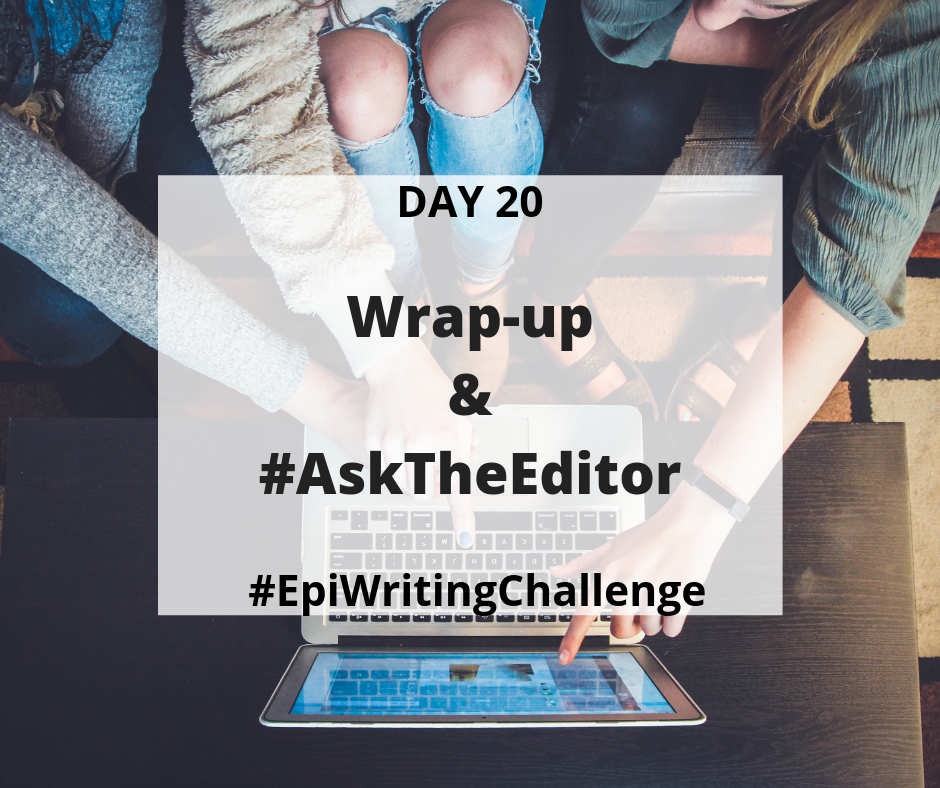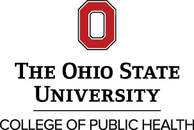|
We heard from Bill Miller, Editor-in-Chief of STD Journal, and Associated Editor at Epidemiology, Tim Lash, Editor-in-Chief of Epidemiology, Andy Olshan, Editor-in-Chief of Current Epidemiology Reports, Petra Wark, Associate Editor at Nutrition Journal, Justin Lessler, Associated Editor at American Journal of Epidemiology, Nicola Low, Deputy Editor at STI BMJ and Specialty Consulting Editor at PLOS Med, and Emily DeVoto, Deputy Editor at Epidemiology.
One of my favorite parts of being part of a professional Twitter community like #EpiTwitter is how it brings together all the ranks – from students to trainees to early career professors and the highest and mightiest. This #AskTheEditor event was a prime example. Bill Miller, the chair of the Epidemiology Department at the Ohio State University proposed the idea, and I eagerly jumped on board. We rounded up some great editors and had people tweet us their questions.
I’ve summarized the great questions and answers exchanged during the course of the day, and categorized them generally below. Be sure to bookmark this page, and feel free to share with colleagues.
Learn more about our participating editors, or jump to the Q&A below.
Being an Editor Manuscript Submissions Peer Review Tips Writing Suggestions
Participating Editors
being an editor
Q1. What’s the most difficult part about being an editor?
Depending on where they are in the 2-month issue cycle, one editor shared that he spends 1-3 hours a day. Tasks include editing submissions, reading proofs, emailing authors and other editors, processing final submissions, and putting together tables of contents. Another editor shared his early bird routine. Between 5 AM and 7 AM nearly every day, he works on new submissions, editor decisions, submissions he is handling, and journal correspondence. Then he devotes 1 day a week to larger tasks such as editorials, journal policies, table of contents, etc. So that’s 2 hours a day, x 5-7 days per week, so 10-14 hours per week. Overall, we learned that the time commitment varies by role. Editor-in-chief for a big journal like JAMA or Lancet is a full time job, but may be 8-10 hours per week for substantive journals or 4 hours a week for associate or deputy editor positions. manuscript submissions
Q3. What are your thoughts on writing and submitting an unsolicited editorial or commentary? Many junior-level researchers are interested in writing up their thoughts in a review or commentary – but it’s clear by the by-lines of those published that those types of articles are typically written by senior investigators. It was great to hear from the editors what goes on behind the scenes with regards to solicited and unsolicited commentaries.
First, check author guidelines or email the editor to find out if a journal takes unsolicited commentaries. Most well-publicised commentaries are invitation-only but some journals do openly invite unsolicited commentaries. Second, approach your professional society’s councilors or representative, as it may be the best way to publish your commentary. Third, if you write a phenomenal review, the editors may ask you to formalize it into a commentary. So, in sum, reach out to the editor to find out if they take unsolicited commentaries and if they think your idea is a good fit, you may get your commentary published. Even though most commentaries and editorials are by invitation, they can be very important for your career – so if you have a good idea, go for it.
Q4. How can an author write a stand-out cover letter, making a compelling case that your journal is the best fit for their paper? What non-required information is most helpful to include?
Our participating editors varied in their preference for cover letter style. While this might seem discouraging (no simple recipe for success), they acknowledged that cover letter length and format is a topic of debate among editors. The reality is that an editor won’t reject your paper as a poor fit simply because they think a cover letter should be a full 1 page and you wrote 1 paragraph. Here’s some comments from our editors on how to write a compelling cover letter to accompany your manuscript submission. One editor prefers short cover letters – something that entices him to read the paper: “I like a letter to be short: 2-3 sentences maximum to show why your work is important. Think of it as an elevator speech for the paper. Other [editors] like a longer letter with more details [about the research] but I get those from the abstract.” Another editor spoke more to the purpose of the cover letter. “The cover letter is your opportunity to a) give your take home message and b) say things that you can’t say in the manuscript. [For example] does your paper follow a ‘red thread’ of the journal? Is there something topical to mention? But be concise.” Some great advice shared by a fellow epidemiologist who heard from one our editors, Timothy Lash, at a SER meeting, was to “mention how your manuscript relates to published papers in the same target journal.” An editor agreed – “it’s a good idea to say that the journal has a track record in the topic area. Journals like to ringfence topics important to them.” Hopefully it’s clear by now that cover letters are not just a formality. One editor revealed that he “reads the cover letters carefully. [They are] an opportunity to explain what is new and important and why the readers will be interested.” More than just window dressing, take advantage of the cover letter to point out why the journal is a good fit, tying your research in with their big picture. What’s the take home message? How can you communicate it in a written elevator speech? For a happy medium between those who prefer short and sweet and those who’d like it long and complete, you might consider stating your topic area, point out that the journal has a track record, share the take home message, and then briefly summarize what you did. The editor will read through it and say “OK, topic relevance, check. Oh, interesting finding. How did they do it? Oh, here’s a brief summary – it was a simulation study based on XYZ. Time to look at the abstract.” peer review
Q5. What are an editor’s tips for responding to reviewer comments? Most of us have been there – we’ve received our submitted manuscript back with reviewer comments. How you respond to those comments, both in writing, and in making changes, may impact that reviewer’s perception and their ultimate recommendation for submission. Hopefully you’ve had a great senior author or advisor that has shown you the ropes on responding to reviewers with niceties. We wanted to hear the editor’s perspective on how they view author responses. Here are their tips.
Read through the reviewer comments and categorize them as “easy” and “hard”. Do the easy things (even if you don’t want to) as long as it doesn’t make the paper worse. This shows that you’re being responsive. Then, do the hard things that make the paper better. Now you have leverage for the hard things that you don’t want to do or that you can’t do. Acknowledge how these would make the paper better and consider discussing as a limitation. Overall, always respond honestly and respond to everything – even if the answer is “we are not going to do that because ____”. “Nothing annoys me more as an editor or a reviewer as an author pretending that they are responsive when they are not. Disingenuousness = rejection” In other words, don’t respond that you changed something, but then that change mysteriously cannot be found. We also shared several ways of responding to reviewer comments. Some depend on the various formats reviewer comments come to you – some are categorized as major or minor by the reviewers, some are barely divided up at all. To start, always include the original reviewer’s comment when you’re responding. When the reviewer gets the manuscript back, I promise they won’t remember what they wrote if you don’t copy it over. For formatting, keep comments divided by reviewer, and consider typing your response under the comment, or putting it all in a table. One editor said that “the worst thing can author can do is rebut most of the comments, but without making substantive changes.” Another editor agreed, and added that “the 2nd worst thing is to answer reviewer in the comments to the editor, and not to the reviewers directly” while also failing to make changes to the manuscript. All in all, editors read both the reviewer’s original comment and the author’s response. The editor’s “goal is to be sure that peer review was effective, and it was honored. If you strongly disagree with a reviewer’s request, consider the following:
Q6. What are your suggestions to address requests for inappropriate analyses from editors or reviewers? Worth education or just submit elsewhere? This question stemmed from a follower sharing that many of their colleagues have been requested to run post hoc analyses. In the discussion, the common request of including p-values in Table 1 also came up.
An editor shared that he has seen editor and reviewer comments that contradict STROBE guidelines even though they represent journals that endorse STROBE. For example, asking for p-values in Table 1 is a common offender. Pointing out the inconsistency with STROBE guidelines will usually fix the situation. You can read the 2014 editorial “Observational Studies: Getting Clear about Transparency” from PLOS Medicine Editors that expands on the most current STROBE checklist. Every reviewer has also been an author – but sometimes we separate the two experiences. Let’s talk now about how to write good comments when you’re the reviewer. Q7. What are an editor’s tips for writing comments as a reviewer? This question originated from my own lab groups breakfast club meeting. We were looking over an edited manuscript we had reviewed together a few months before. We read through the reviewer comments, interested to see what other reviewers had written, and then made our way through the changes the authors made. Some of the reviewer comments came off a bit rude, and some hid their main point in endless qualifiers. When put our question to #AskTheEditors, we got some great feedback on how to phrase our reviewer comments. First and foremost, write reviews respectfully. This ‘rule’ came from nearly every participating editor.
Next, write your reviews so they accomplish what they’re supposed to. You’re providing your perspective on the science, and helping improve their paper – not tearing down every argument they’ve built. One editor pointed out that “your review is a reflection of the journal. When a review is mean, or simply bad, it reflects poorly on the journal and then an author may not submit future papers to that journal” – or they may discourage colleagues to submit. Here’s some tips for writing good (read: helpful) reviewer comments. be helpful
be clear
The editors also had some points to make on formatting and writing comments to the editors. formatting
comments to editors If you feel like there is part of the paper you can’t assess, tell the editors. Nobody expects you to be an expert in all areas, so in your comments to the editor, let them know that you think a section needs substantive or methodologic review. They appreciate it. In your comments to editors, consider that “editors want different things than authors.” They want an assessment of the big issues – are the big issues fundamental, or only require minor improvements? “Focusing too much on minutiae, like minor changes from the authors, does not help” the editor decide if the paper should be accepted. Q8. Is it common for editors to request substantive changes to a paper after acceptance by reviewers? This happened with the discussion section of my first ever paper. One editor responded that while it is likely not common, it is reasonable because editors often serve a reviewer function as well. writing
Q9. What are your thoughts on creating good figures?
Ideally, figures should speak on their own (through prose in the caption) but keep in mind that while some readers can see your paper’s abstract and figures, some can only see your abstract. If the journal requires a central illustration or figure, know that the central illustration should tell the full story of the paper and cover all major points. Q10. What are your discussion section pet peeves? This deceptively simple question sparked quite a gold-mine of discussion from our editors. Here’s a summary of their tips. Some of these pet peeves run directly against the classic “discussion rubric” which includes strengths, limitations, and recommendations for further research. discussion pet peeves
Helpful resources: Ken Rothman’s “Writing for Epidemiology” in Epidemiology (1998). [About Kenneth J. Rothman]
Did we miss anything? Leave your comments below, or tag us on Twitter using #AskTheEditor @BaileyDeBarmore @BillMiller_Epi @TimothyLash to get the discussion going again.
Interested in participating in our next #AskTheEditors? We are looking for editors and associate editors on Twitter for our next round, particularly those who identify as women or minorities. Contact Bailey at @BaileyDeBarmore or via the contact form to find out more.
Learn more about the #EpiWritingChallenge and check out all of the blog posts summarizing each topic from our 20 day challenge.
Related Blog Posts
0 Comments
Your comment will be posted after it is approved.
Leave a Reply. |
popular postsLike what you read?
categories
All
archives
July 2024
This website uses marketing and tracking technologies. Opting out of this will opt you out of all cookies, except for those needed to run the website. Note that some products may not work as well without tracking cookies. Opt Out of Cookies |


































 RSS Feed
RSS Feed